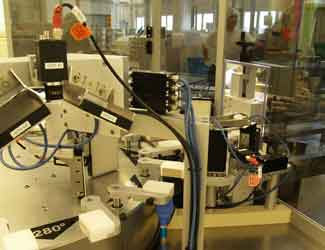信息來源于:互聯(lián)網(wǎng) 發(fā)布于:2021-08-24

Boehringer Ingelheim, the world’s largest family-owned pharmaceutical company, produces around 120 million blister packs a year. The prescription-only drug products in Boehringer Ingelheim’s blister packs are manufactured to reduce blood pressure, treat patients experiencing shortness of breath, and treat thrombosis. These products get into patients’ hands via pharmaceutical wholesalers and pharmacies. In the past, the company relied on human inspections to ensure the quality of the printing on their blister packs, even though regular random sampling did not allow for meaningful conclusions about quality to be drawn. Under normal circumstances, the human eye can usually see printing on a blister pack or folding pack of medication easily. However, when faced with the task of inspecting printing quality on a production line churning out around 300,000 blister packs and 100,000 folding packs every day, employing a "human sensor” to inspect products randomly cannot meet the demand of perfect quality control. At this level of production, Boehringer Ingelheim now relies on the vision competence of Cognex and Weber Systemtechnik to achieve its quality control objectives.
In Boehringer Ingelheim’s production process, blister packs pass over a narrow belt at a speed making it is impossible for the human eye to see any more than the outline of the individual objects. Today, the state-of-the-art vision technology that Boehringer Ingelheim had deployed to inspect blister pack printing ensures one hundred percent error-free quality. Absolute transparency in the production process has replaced the unreliable projections made by humans.
On the manufacturing floor, four inspection stations have been deployed for inspecting the printing of blister packs as well as a brand new unit for inspecting folding medication packs. At Boehringer Ingelheim every single product gets a quality inspection. This has been made possible by Wesys-OCR vision software based on VisionPro® from Cognex.
Quality under pressure
In principle it appears perfectly simple: a camera identifies a series of letters and numbers, rejects defective objects and moves accepted objects though the production process. On a factory floor, there are two factors that make this process challenging: the enormous speed at which the blister packs move and the accuracy of inkjet printing. Inkjet printing is very flexible and practical, but it can be highly inaccurate when it is required to print consistent clear images on foils with irregular surfaces such as blister packs. To the untrained eye, inkjet printing may appear perfectly OK but does not, in fact, satisfy a customer’s quality assurance standards. Small spots of ink not applied where they are supposed to be can be enough to cause a product to be rejected, and the pharmaceutical market in Asia is especially quality-focused in this respect.
Intelligence shows strength
Boehringer Ingelheim achieves perfect quality control by deploying a commercially-available industrial camera in each of the four blister pack inspection units, supported by LED ring light, which detects the printed undersides of the foil in fractions of a second. The information is transferred to the VisionPro-based Wesys-OCR vision software at lightning speed so that it can perform a precise sample comparison. Depending on the product type, particular examination is made of varying details which are applied—including lot number and expiry date—in addition to looking at pre-printed information.
The intelligent vision software knows and recognizes all the relevant symbols and letters and, on the basis of previously-taught parameters and tolerance limits, assesses the quality of a product. The VisionPro-based Wesys-OCR is particularly characterized by its library of flexible, high-precision and easy-to-handle tools. It is possible to compile even complex product profiles which are accurate in every detail. Its particular strengths in the field of reliable sample comparison ensure that even reflections due to uneven surfaces and the changing foil colors of silver and white do not affect reliable inspection. VisionPro-based Wesys-OCR reacts intelligently in these instances to fluctuations in print position and print quality.
VisionPro handles additional challenges
The greatest enemies to detecting unacceptable print quality in the folding pack are dirt, pressure, and sharp edges. In instances where these factors are present, VisionPro-based Wesys-OCR ensures that defective folding packs are prevented from reaching the customer. Supported by white LED surface illumination, six industrial cameras examine the six sides of each individual pack—up to 80 a minute—to ensure quality control. Dirt, pressure, and sharp edges generally do not affect quality control of blister packs but there are sometimes exceptions. On the rare occasions blister packs contain slight dirt or damage, incorrectly glued tabs, and print errors, VisionPro-based Wesys-OCR ensures that the products are handled appropriately.
The system can be operated via touchscreen or keypad. The employee feeding the packs into the inspection process by hand determines the proper product format. The employee selects the specified data from a clear list and starts the inspection process at the touch of a button. The interaction between human and advanced technology occurs swiftly and simply and ensures consistently high quality.